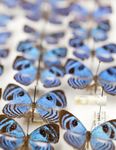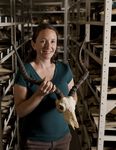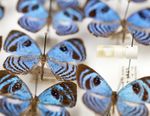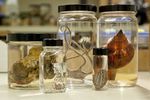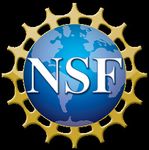EXTENDING U.S. BIODIVERSITY COLLECTIONS - TO PROMOTE RESEARCH AND EDUCATION - AIBS
←
→
Page content transcription
If your browser does not render page correctly, please read the page content below
ON THE FRONT COVER. With more than 10 million specimens,
the McGuire Center houses one of the world’s largest Lepidoptera
collections, representing most of the world’s 20,000 butter-
fly species and many of the estimated 245,000 moth species.
Credit: Eric Zamora, Florida Museum of Natural History
Contents
1 Summary
2 Background
3 The Extended Specimen Network
5 Foundation for the
Extended Specimen Network
7 Empowering 21st Century Learners
through Biodiversity Knowledge
8 Implementing and Sustaining
the New Agenda
Verity Mathis, collection manager for
mammalogy, holds a skull of an impala,
Aepyceros melampus, in the mam-
mals collection at the Florida Museum.
b Credit: Kristen Grace, Florida MuseumSummary
Our national heritage of approximately one billion biodiversity specimens
includes such diverse objects as dinosaur bones, pressed plants, fish preserved
in alcohol, pinned insects, eggshells, and microscopic pollen grains. Collectively
these specimens form a powerful resource for exploring Earth’s biota across tax-
onomic, temporal, and spatial scales.
There is an urgent need to build a network of extended specimen data
that represents the depth and breadth of the more than one billion biodiversity
specimens held in U.S. collections institutions. The Extended Specimen Network
(ESN) would include the physical specimen and its associated physical and digi-
tal genetic, phenotypic, and environmental data. The network would rely on new
data integration mechanisms necessary to link all of the dynamic components
together. The ESN will help researchers understand the rules that govern how
organisms grow, diversify, and interact with one another, and how environmen-
tal change and human activities may affect those rules. As a resource for formal
and informal education (including citizen science), the ESN will provide scalable
learning opportunities for K–12 and lifelong learning in data literacy as well as
the life sciences and humanities.
The ESN will require long-term funding for a central
organizing unit with responsibility for community
coordination, education, mobilization, and mainte-
nance of the central data repository and the network
infrastructure. Also critical to the success of the ESN will
be new infrastructure to provide the linkages between
the specimen and derivative data, continued specimen
digitization and data standardization, new collection
protocols, new approaches to data sharing and collab-
oration, and enhanced partnerships with data provid-
ers, computer and data scientists, and educators.
ABOVE. A variety of specimens in an
invertebrate zoology collection. Credit:
Kristen Grace, Florida Museum
RIGHT. Field notes from Rachel Hackett’s
graduate research on prairie fen biodiversity.
Specimens were deposited in the Central
Michigan University Herbarium. Credit:
Peggy Brisbane, Central Michigan University
1 1Background
Investment by the U.S. federal government through the THE EXTENDED SPECIMEN
National Science Foundation’s Advancing Digitization of
Biodiversity Collections program (ADBC) has facilitated the Science and industry rely on physical specimens housed in
digitization of approximately 62 million U.S. biodiversity U.S. biodiversity collections. Rapid advances in data gen-
specimens since 2011. The program has provided support eration and analysis have transformed understanding of
to the University of Florida and Florida State University for biodiversity collections from singular physical specimens,
hosting the Integrated Digitized Biocollections (iDigBio). to dynamic suites of interconnected resources enriched
IDigBio is the central coordinating unit for the digitization through study over time. The concept of the “extended
effort and hosts the national data repository. The final specimen” conveys the current perspective of the biodiver-
ADBC grants will be awarded in 2021. During the past year, sity specimen as extending beyond the singular physical
the Biodiversity Collections Network (BCoN) has led an object, to potentially limitless additional physical prepara-
effort to gather input from primary stakeholder communi- tions and digital resources.
ties regarding future directions for collections and their use
in research and education. The effort culminated in a work-
shop held 30 October – 1 November 2018 at Oak Spring
Garden in Upperville, Virginia, during which a strategy was
developed to maximize the value of collections for future
research and education by building on and leveraging the Abigail Hollingsworth, Central Michigan
accomplishments of ADBC. University (CMU) undergraduate, digitizing
plant specimens in the CMU Herbarium. Credit:
Peggy Brisbane, Central Michigan University
2Keith Curry-Pochy discusses snake patterns with a
child during a snake-themed Tot Trot event in affilia-
tion with the Discovery Zone at the Florida Museum.
Credit: Kristen Grace, Florida Museum
The Extended
Specimen Network
Building on the accomplishments of the past decade, the
next step in advancing and enhancing collections infra-
structure should focus on the production of extended
specimens that represent the depth and breadth of bio-
diversity held in U.S. collections. Existing specimens are
extended through digitization and linkages with associ-
ated data, including genetic, phenotypic, behavioral, and
environmental. New specimens will be collected with
these extended attributes in mind. Combined with and
even driving data integration technologies and relevant
data layers, extended specimens will form the core of a
powerful Extended Specimen Network, or ESN.
ENABLING SCIENTIFIC DISCOVERY
The ESN will stimulate new avenues of investigation, expe- elties among existing and newly collected specimens.
dite existing ones, and provide a more usable resource for Current data portals for digitized specimen data have
making science-based policy decisions. By linking physical user interfaces designed primarily for use by taxonomists
specimens to the data derived from them, such as gene and collections professionals. To take full advantage of
sequences, images, behavior and species interactions, the richer data content and broader relevance of the ESN,
we can better define and understand the traits that com- we must develop interfaces for a more diverse user base.
prise an organism. Such information has direct benefits to With existing interfaces, a user can retrieve a set of relevant
society and quality of human life, including how zoonotic occurrence records from a search based on taxonomic
diseases are transmitted and controlled, how crops can be name or a geographic unit. However, the ESN must provide
more effectively and efficiently grown in changing climates, an interface that will allow users to ask such questions as:
and how we can sustain and use biological resources in Do the available data comprise a representative set, or are
our ocean. The envisioned result is an integrated, global critical data lacking because key specimens have not been
enterprise of specimen-based data that will also benefit collected and/or digitized? How many different species,
non-biodiversity-related research and commercial enter- as opposed to different species names, occur in a given
prises today and into the future. region? Do the organisms of the region occur in popula-
The ESN will facilitate the as yet incomplete work of doc- tions that are genetically distinct from other populations of
umenting and naming the organisms that make up Earth’s the same species? Have unique interactions among organ-
biodiversity. Machine learning and other innovative data isms been documented in the region of interest?
science and engineering techniques can use the full range
of data available about known species to find hidden nov-
3High-resolution computed tomography recon-
struction of an Angler, Lophius piscatorius
(UF 118531). Credit: Zachary Randall, FLMNH
ENABLING SEAMLESS DATA INTEGRATION, ATTRIBUTION, AND USE TRACKING
The system of identifiers and specimen tracking protocols Improved specimen tracking will create the potential
needed to implement the ESN will enable the linking of for cost recovery when specimens are used in commercial
extended specimen objects, elucidation of relationships enterprise. The ability to work with novel research (e.g.,
between items in disparate collections (e.g., tissue:voucher, pharmacology, human health, food security) and com-
plant:pollinator, host:parasite, and facilitation of interoper- mercial communities (e.g., pharmaceuticals, agriculture)
ability with data sources) outside of our immediate realm. will demonstrate the value of collections outside the
It will also allow collections institutions to identify the use immediate stakeholder community and contribute to the
of their specimens and develop metrics for measuring their increased sustainability of biodiversity collections.
impact. Such metrics permit collections to demonstrate A comprehensive data tracking system will also allow
their value and better acquire and manage resources. biodiversity collections to meet new requirements for
Currently, collections lack access to the data that demon- documenting the use of specimens and data derived
strate their full contributions to specimen-based research from them. Such a requirement is the Nagoya Protocol,
through citation in publication, vouchering of Genbank which is a supplementary agreement to the Convention of
sequences, or products created from direct specimen use Biological Diversity (CBD) that establishes an international
(e.g., images, CT scans). A reliable mechanism of tracking legal framework for access and benefit sharing of genetic
such use must be built. resources. It requires that countries providing specimens
define their access procedure and requires users to report
4 on and share benefits upon their use.Foundation for the
Extended Specimen Network
COMPLETE AND IMPROVE EXISTING
DIGITIZED DATA
A significant proportion of the existing digitized specimen
records are incomplete. Some records, having been entered
as “skeletal” records, lack important data fields (e.g., locality, FILL GAPS IN BIODIVERSITY DATA
date, collector) while geocoordinates are lacking for most.
These data gaps limit the utility of these data, and thus data Biological collections comprise the most comprehen-
records must be completed and standardized to maximize sive record of life on Earth, yet their potential cannot be
their value in the ESN. Development of computational tools fully realized until the data contained within them are
that can help fill in, or at least infer, missing values must be revealed and made computationally accessible. Many of
a high priority, perhaps taking advantage of a combination the approximately 1,469 U.S. collections are not yet digi-
of image analysis (including optical character recognition) tized, and some do not have accurate estimates of the
and data pattern matching. size or taxonomic content of their holdings. We must take
stock of the holdings in U.S. collections by characterizing
their holdings in terms of taxonomic, temporal, and geo-
graphic emphases, and compile these data into a national
collections index. The existing Index Herbariorum, an index
to plant collections, is a model. Such a reference enables
prioritization of collections for digitization to create an
effective national resource.
Biodiversity specimens are a resource for documenting
environmental change, and researchers must continue to
collect them into the future. New collections are especially
important in areas that are undergoing rapid change, such
as the Arctic. A more holistic, next-generation approach to
the collection of new biodiversity specimens is needed. As
Schindel and Cook (2018) note, a next generation approach
could focus on nested sampling that extends beyond the
single organism (e.g., a single plant) to its biotic associates
(e.g., soil microbes, epiphytes, endophytes, and parasites
spanning from viruses to insects and fungi) and its environ-
ment (e.g., community composition, microclimate, macro-
climate, habitat quality). The downstream integrative link-
ages between these nested samples will open up new and
dynamic research opportunities using these collections.
Distinguished scientist, Pamela Soltis, works on
the Tree of Life – a collaborative effort of biol-
ogists and nature enthusiasts from around the
world to understand biological diversity. Credit:
Kristen Grace, Florida Museum
5BUILD AND STRENGTHEN STRATEGIC PARTNERSHIPS
The ESN will require expanding existing partnerships and and historical and current occurrence records. Further,
creating new strategic engagements. standards for the extended specimen data that are driven
by the ESN will make the data collected by future research-
Computer and data science research communities. ers using these centers more computable.
The ESN requires strong interdisciplinary development
between biology, biological collections, and computer and International Biodiversity Organizations. Participation
data sciences communities in order to build and maintain to the fullest extent possible in the Global Biodiversity
next generation collections infrastructure and accessibility. Information Facility (GBIF) proposed alliance for biodi-
versity knowledge will facilitate local work and help align
Aggregators of related data. The data needed to efforts to observe and measure U.S. biodiversity in rela-
extend biodiversity collections are held in databases such tion to other global efforts, including the Atlas of Living
as the Catalogue of Life checklist, the Biodiversity Heritage Australia (ALA) and the Distributed System of Scientific
Library (BHL), the Barcode of Life Data System (BOLD), Collections (DiSSCo), a new European Union program. At a
National Center for Biotechnology Information (NCBI), and local scale, we must pursue collaboration with data aggre-
the Encyclopedia of Life Traitbank. Creating an effective gators in Mexico (CONABIO) and Canada (Canadensys) to
two-way means of data exchange with these resources is permit the seamless transfer of data needed for continen-
required. Collaboration with programs such as the NSF- tal-scale understanding of the breadth of biodiversity and
funded National Ecological Observatory Network (NEON), its distribution and change over time.
Long Term Ecological Research Network (LTER), and Critical
Zone Observatories (CZO) will ensure that standards and Education and Broadening Participation. Working with
protocols enable interoperability between collections data national educators organizations as well as groups, such as
the Society for Advancing Chicanos and Native Americans
in Science (SACNAS), Minority Serving Institutions (MSIs),
Historically Black Colleges and Universities (HCBUs), and
other higher learning institutions, will promote the devel-
opment of a more diverse scientific workforce. Partnerships
among robust and fledgling citizen science initiatives will
promote projects that can be widely implemented with
compatible data standards and protocols.
Other Partnerships. An openness to collaboration with
non-traditional partners in academia and industry could
lead to wider application of pertinent technology. As the
breadth of users and the value and diversity of products
generated from digitized collections data grows, so too will
support for investments in biodiversity collections.
ABOVE. Lichen students at
Highlands Biological Station, North
Carolina. Credit: James Lendemer,
NY Botanical Garden
RIGHT. Closeup photo of
Tetracha virginica collected from
Kansas field site by NEON staff.
Credit: Eddie Minnick
6Field technicians Maddie Pike
and Frank Schroyer prepare
for small mammal sampling
at the Konza Prairie LTER site.
Credit: Becky Eaves
Empowering 21st Century Learners
through Biodiversity Knowledge
FORMAL EDUCATION INFORMAL EDUCATION
Through education, the ESN and collections community has As our digital resources continue to expand, so too will
the largest potential to engage, educate, and empower the informal education opportunities. Indeed, we probably
next generation of biodiversity data stewards, biodiversity cannot realize the full expression of the ESN without the
researchers, and ESN users. Biodiversity data and ESN usage strong involvement of the citizen science community.
aligns naturally with core content common to all K–12 sci- A number of citizen science projects are based on mon-
ence curricula and the undergraduate biology core, and itoring biodiversity. Ebird, ebutterfly, iNaturalist, and the
can be included seamlessly in evolution, biodiversity, sys- U.S. Phenology Network, for example, provide platforms
tematics, taxonomy, and ecology subject matter. Specimen- for minimally trained individuals to contribute sightings
based data make science accessible through the specimen or recordings of organisms or a particular attribute of an
itself, which is tangible, place-based, and engaging, as well organism. Internet-based projects can involve the public
as through aggregated specimen data that are verifiable, directly in contributing to collections-based science and
relevant, and a logical gateway to data literacy (Monfils databases. Projects such as Notes from Nature, Smithsonian
et al., 2017). The place-based capacity of collections data Transcription Center, and CitSciScribe are platforms that
combined with the social and societal relevance of biodi- invite the online public to add digital data to images of
versity science can play a role in creating inclusive, cultur- specimens. Tasks range from transcription, to morpholog-
ally relevant, and socially conscious educational materials ical measurements, to phenological annotation, and the
that engage a broad and diverse audience in biodiversity majority relate directly to an active research project. Such
science. By defining and infusing biodiversity data literacy programs engage participants from a wide range of ages,
skills, creating a learning progression that incorporates ESN abilities, and interests, and with minimal startup costs. This
data and biodiversity data literacy into formal education, approach creates an inclusive and diverse group of individ-
and providing accessible materials, teacher training, and uals working to advance biodiversity science.
educator interfaces that facilitate incorporating ESN data in
the classroom, we support a biodiversity literate society and
the training of the next generation of data literate scientists.
7Implementing and Sustaining
the New Agenda
Key to the success of the ESN is a securely funded, long-term coordinating unit that
builds upon the current model of the digitization iDigBio hub, but that has expanded
functionality. The ESN hub would manage the national specimen data repository and
network infrastructure and, in partnership with the primary stakeholder community,
carry out the activities needed to implement the ESN described in this document:
• Develop a robust, comprehensive specimen identifier • Create an authoritative, comprehensive, and self-
system in collaboration with other international data updateable index of U.S. collections institutions with
aggregators and providers. structured metadata to describe their holdings to expe-
• Work with data creators and providers to extend biodi- dite discovery of critical undigitized collections.
versity specimens to create stable data linkages. • Continue digitization of existing material focused on
• Develop new user interfaces that take advantage of underrepresented taxa (e.g., insects, fossils), including
the power of the ESN and serve a broader range of specimens held in small regional, personal, and individ-
potential users of these data for education, research, ual researcher collections.
and conservation. • Improve previously digitized specimen data by imaging
specimens, completing skeletal records, and augment-
ing data with georeferencing.
• Develop new protocols for the collection and acces-
sion of data-rich samples that provide greater context
for understanding the biotic and abiotic interactions
of organisms and create comprehensive data sets for
research and education.
• Champion broad-scale adoption of core biodiversity
data literacy skills and competencies in K–12 and under-
graduate curricula.
• Support enhanced training of emerging and established
professionals for interdisciplinary work in biodiversity,
data science, and informatics.
ABOVE. An articulated eastern
diamondback rattlesnake skele-
ton (Crotalus adamanteus). Credit:
Kristen Grace, Florida Museum
RIGHT. Aldo Rincon and Alex Whiting
move fossil jackets into a prep lab.
Credit: Kristen Grace, Florida Museum
8Larry Page, curator of ichthyology,
demonstrates the use of a photo
box. Using the Photo Box Plus and a
copy stand, specimens are photo-
graphed and cataloged digitally
and added to an online database
for scientists and researchers
around the world to search, allow-
ing better access to collections
and reducing the need to loan
and ship delicate items. Credit:
Kristen Grace, Florida Museum
References Preferred Citation
Monfils, A.K., K.E. Powers, C.J. Marshall, C.T. Martine, J.F. Smith, and Biodiversity Collections Network. 2019. Extending U.S. Biodiversity
L.A. Prather. 2017. Natural history collections: Teaching about bio- Collections to Promote Research and Education. American Institute of
diversity across time, space, and digital platforms. Southeastern Biological Sciences, Washington, DC, 8 pp.
Naturalist 16(sp10), https://doi.org/10.1656/058.016.0sp1008.
Schindel, D.E., and J.A. Cook. 2018. The next generation of natural
history collections. PLoS Biology 16(7):e2006125, https://doi.org/
10.1371/journal.pbio.2006125.
Webster, M.S. 2017. The extended specimen. Pp. 1–9 in The Extended
Specimen: Emerging Frontiers in Collections-based Ornithological
Research. Studies in Avian Biology (no. 50), M.S. Webster, ed.,
CRC Press, Boca Raton, FL.
This material is based upon work supported by the National
Science Foundation under Grant No. DBI-1441785. Any opin-
ions, findings, and conclusions or recommendations expressed
in this material are those of the author(s) and do not neces-
sarily reflect the views of the National Science Foundation.
9https://bcon.aibs.org
Biodiversity Collections Network
c/o American Institute of Biological Sciences
1201 New York Avenue, NW, Suite 420
Washington, DC 20005
Graduate student Jordan Hoffman
sampling reindeer lichen
(Cladonia) mats on Whiterock
Mountain in Nantahala National
Forest, North Carolina, as part of
population genomics research.
Credit: James Lendemer,
NY Botanical Garden
10 March 2019You can also read
